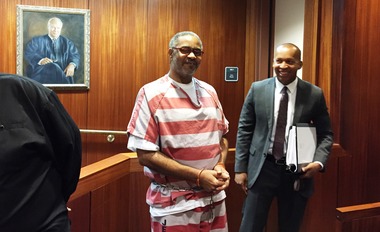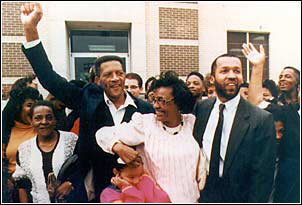
Hinton with Stevenson
Bryan Stevenson has done it again!
Anthony Ray Hinton, one of the longest serving death row prisoners in Alabama history, has been exonerated thanks to Stevenson and the Equal Justice Initiative that he founded. Hinton spent 30 years incarcerated for a crime that he did not commit.
I describe in my book, Circumstantial Evidence, how Stevenson proved another black man on Alabama’s death row innocent more than two decades ago. Walter “Johnny D” McMillian was condemned to death for the 1986 murder of a white teenage girl after two witnesses testified that they’d seen his truck parked at the scene of the killing and another witness claimed that he actually had see McMillian standing over the dead girl during a robbery. The case against McMillian seemed indisputable until Stevenson began investigating.
Stevenson and his legal team were able to prove that the witnesses’ statements were false and the eye-witness, who’d claimed to have seen the murder, was a lair trying to save his own neck in an unrelated case. Even worse, Stevenson discovered that the prosecution had hidden crucial evidence that proved McMillian was innocent.
Despite this, Alabama officials refused to free McMillian. (One told me privately that he was not going to release a black man accused of killing a white girl until he had another one to put on death row.) It took a 60 Minutes segment about the case to shame local and state officials into releasing McMillian. 
In this new case, Anthony Ray Hinton was sentenced to death for fatally shooting two managers in separate robberies of Birmingham fast-food restaurants in 1985. There were no eyewitnesses or fingerprint evidence; police had no suspects and pressure to solve the murders grew as similar crimes continued. On July 25, 1985, a third restaurant was robbed and the manager was shot but not seriously wounded. Hinton was arrested after the manager identified him from a photo lineup, even though he was working in a warehouse fifteen miles away at the time of the crime. Police seized an old revolver belonging to Mr. Hinton’s mother, and state firearm examiners said that was the gun used in all three crimes. The prosecutor—who had a documented history of racial bias — said he could tell Mr. Hinton was guilty and “evil” solely from his appearance.
At the time, Hinton was 29 years old with no history of violent crime. A polygraph test given by police exonerated him, but the judge refused to admit it at trial. The court appointed lawyer failed to find a qualified firearms examiner to review the evidence leading to Hinton being convicted and sentenced to death. Thanks to Stevenson’s dogged determination, Hinton’s case went before the United States Supreme Court last year and it unanimously overturned his conviction based on his attorney’s deficient representation and demanded a new trial.
Stevenson and his legal team hired the former chief of the FBI’s firearms unit and he testified that the bullets from all three crimes could not be matched to a single gun, much less to the weapon that the police claimed Hinton used. That same expert pointed out that the bullets used in the third robbery could not have been fired from Hinton’s gun — they were the wrong caliber — so it would have been impossible for him to be the shooter.
“Race, poverty, inadequate legal assistance, and prosecutorial indifference to innocence conspired to create a textbook example of injustice,” Bryan told reporters. “I can’t think of a case that more urgently dramatizes the need for reform than what has happened to Anthony Ray Hinton.”
My good friend, Walt Harrington, who worked with me at the Washington Post, first introduced me to Bryan in the mid-1980s. Walt had written a profile for the Post about Bryan’s death penalty work in Alabama and had compared him to a living saint. I had just finished my book, The Hot House: Life Inside Leavenworth Prison, and the inmates there had told me that if I wanted to find someone who had been wrongfully accused, I needed to visit a death row.
I thought that was an outrageous statement at the time, but it proved to be true. The chances of you being wrongly convicted of a crime are higher in murder cases than any other. I decided to look into the McMillian case because he was a black man accused of killing a white teenager in Monroeville, Alabama, the town that inspired Harper Lee to write the classic: To Kill A Mockingbird. I wondered how much had changed since the imaginary Atticus Finch put a spotlight on racism.
The first time that I spoke to Bryan, he told me that he could prove Walter McMillian was innocent. I was skeptical but if you read my book, you will learn that Bryan was right. (You’ll also discover that the suspect who the Alabama Bureau of Investigation believed was the actual killer sought me out and wanted to be interviewed for the book. He bragged about the killing. Yet he was never arrested or charged. He was white and from a well-known family.)
Since the publication of Circumstantial Evidence, I have watched Bryan become one of the most respected death penalty advocates in the world. He has won numerous humanitarian awards, yet he has donated the more than a million dollars awarded him to EJI to fund death row investigations. In addition to freeing innocent men on death row, he has fought tirelessly to keep children from being sentenced to life without parole prison terms.
Bryan described his crusades and the McMillian case in his book, JUST MERCY, which was published in October 2014 and was an immediate and well-deserved best-seller.
During my career, I have met many famous and influential men and women, but none has impressed me as much as Bryan Stevenson. He is also the best public speaker that I have ever heard. If you wish to be inspired, take a few moments to watch his TED talk.
If two of Alabama’s death row inmates were wrongly accused and convicted, primarily because they were poor and black, you have to wonder how many more are there like them still sitting on death rows?
My friend Walt Harrington got it right when he described Bryan as a living saint more than three decades ago!



